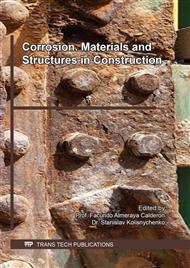p.57
p.64
p.71
p.81
p.87
p.95
p.100
p.105
p.110
Effect of Water Conditions on Macro-Cell Corrosion Potential Difference and Current Density of Reinforcing Steel in Concrete
Abstract:
In marine concrete structure, corrosion behaviors of reinforcing steel in atmosphere, splash, water-level-fluctuating and underwater zone are significantly different. This paper investigated and analyzed the effect of water conditions on the macro-cell corrosion potential difference and macro-cell current density of steel in concrete free of chloride and concrete contaminated by chloride. Results indicated that in concrete that is free of chloride and with low water content, its resistance becomes the limiting factor for the formation of macro-cell current. The increase of water content of concrete could promote the flow of macro-cell current. In concrete contaminated with chloride, only the water-saturated state of anode was little helpful to inhibit the macro-cell current, but the increase of water content of concrete around the cathodic steel could weaken the macro-cell corrosion. The water condition of cathode and anode could play an important role in controlling the ratio of magnitude of macro-cell current to micro-cell current.
Info:
Periodical:
Pages:
87-94
Citation:
Online since:
February 2020
Authors:
Price:
Сopyright:
© 2020 Trans Tech Publications Ltd. All Rights Reserved
Share:
Citation:



